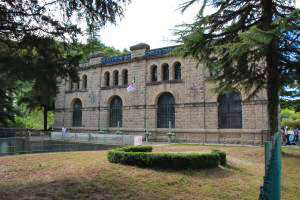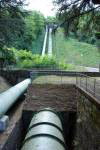| Card n. | Description | Locality | Linked sites |
| 95 | Castelviero power plant and canal | Nervesa della Battaglia | 174 - 173 - 197 |
| file .pdf | Industrial Archaeology (AI) | Google maps |
 |
 |
 |
- Description
- How to get there
- Interesting facts
- Bibliography
The ENEL hydroelectric plant, built in 1930 has maintained its original function, using the waters of the Piave along the middle stretch between Fener and Nervesa, via a canal that runs partly on the surface and partly through a tunnel. The Castelviero power plant and canal are part of the “Brentella-Basso Piave”, system, which uses the flow of water from the Brentella and Vittoria canals, belonging to the dam and reservoir consortia.
At Nervesa, on the Piave, is the Destra Piave Consortium dam (173 AI), completed in 1925 thanks to the tenacity of the writer from Treviso Antonio Caccianiga and his nephew Gino. The work is part of the Vittoria Canal system, which comprises two hydroelectric plants on the Priula canal and fifteen plants on the Piavesella canal, two of which belong to the “Destra Piave” consortium. The initial work on the structure consisted of building a concrete weir, a sluice gate and the building itself, inside which were the gates that channelled the water into the Vittoria Canal, where it was used for irrigation purposes and to supply the two hydroelectric power stations.
The Castelviero power plant and the dam works can be reached from the centre of Nervesa della Battaglia by going along Via Fra Giocondo, which runs parallel to the discharge canal of the waters.
To reach the Ossuary from the centre of Nervesa, follow the tourist signs for Via Ossario from Via Armando Diaz.
ACCESSIBLE: yes
MUNICIPALITY: Nervesa della Battaglia
PLACE: Castelviero – Campagnole di Sotto
GEOGRAPHICAL COORDINATES: dam X 1747837 – Y 5081076; Ossuary X 1748360 – Y 5079904
PROVINCE: TV
FILE COMPILED BY: Antoniol
Two kilometres from the centre of Nervesa della Battaglia is the war memorial to the victims of the First World War, which contains the remains of 9325 soldiers from 120 cemeteries scattered along the middle stretch of the Piave. The Ossuary (197 HAA), designed by the Roman architect Felice Nori, was completed in 1935. The four-storey building rests on a large square base in pale-coloured stone; on the top floor is the Montello Memorial Museum.
C. Pavan, Le dighe e le centrali idroelettriche del bacino del Piave, Santa Lucia di Piave, 2001
G. Pegoraro, ll Consorzio Canale della vittoria e Opere di Compimento Bonifica, 1968
G. Marta, Il Canale della Vittoria, Treviso, 1961

